Saturday, October 04, 2008
The Punisher Presents: Nice, Orderly Sound Effects.
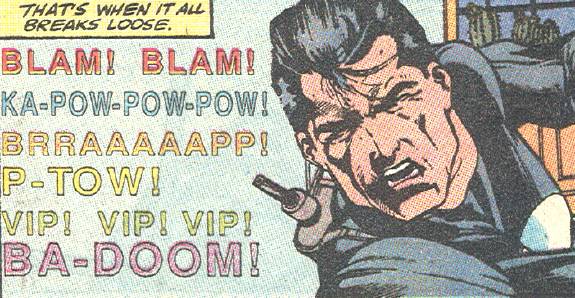
from Punisher Annual #3 (1990) by Mike Baron & Neil HansenAnd seriously, the third one down...is someone farting at the Punisher?
Friday, October 03, 2008
Something I miss.
When a 1970s Marvel comic would incorporate a text page into a story, like so: 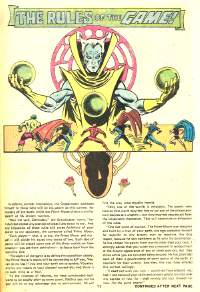 I mean, as long as they didn't do it too often. Though this issue of Howard the Duck was pretty much nothin' but, and that was pretty good. Hmmm. Steve Gerber wrote both the Howard the Duck and the issue of Giant Size Defenders that page up there came from. And he did this in a Man-Thing or two as well. Mr. Gerber did love his prose comic pages. Another thing I liked about this issue of Giant Size Defenders was this brief exchange. Nighthawk and Daredevil had met as adversaries before, causing DD to be a bit distrustful of this fellow, but it doesn't take a whole lot of convincing to get DD to throw in with him: 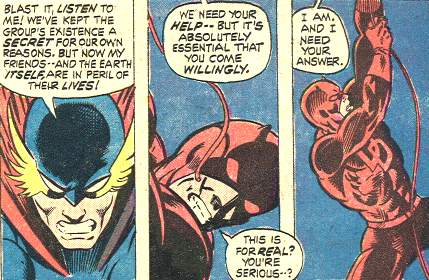
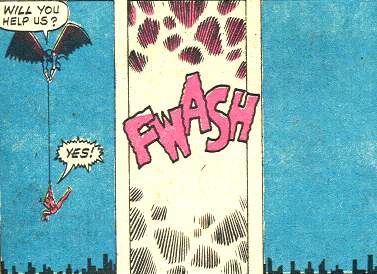 Of course, Daredevil may have been using his super-hearing to monitor Nighthawk's heartbeat like a human lie-detector...but I prefer to think that DD, like most Marvel heroes, is just easily convinced (as discussed before - third entry in the post). By the way, my old pal Cully talked me into buying this Giant Size Defenders, like, fifteen years ago. "Hey, you ever read this comic?" he asked. "Why, no," sez I. "Oh, man, it rules," countered Cully, and swayed by his persuasive argument, it's now in my collection all these years later. And he was right...the Defenders fighting the Grandmaster, an old Dr. Strange reprint, a kick-ass Golden Age Sub-Mariner story...well worth the $2 or so I spent on it. images from Giant Size Defenders #3 (1975) by Steve Gerber, Jim Starlin, Len Wein, Dan Adkins, Don Newton, Jim Mooney, and a partridge in a pear tree
Thursday, October 02, 2008
"UNNN UNH"
More comics badassery - Ka-Zar's pal Zabu beats the tar out of a bunch of AIM agents: 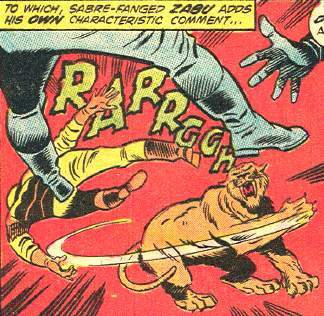
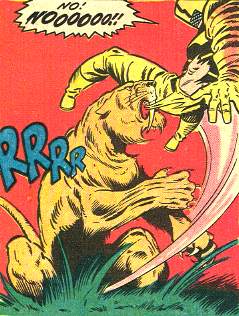 HOLY CRAP. The blood-red (well, more or less) backgrounds certainly add to the holy-crapness. Okay, that wasn't the reason I pulled out this particular comic ( Astonishing Tales #13 from 1972)...what I wanted to say was that the comic contains a very early appearance of Man-Thing, where some of Man-Thing's attributes are a bit different from the currently accepted version of the character. Man-Thing is, as the character is used now, mindless and voiceless, a shambling heap of plantlife and muck with no semblance to humanity. So, this panel is pretty much impossible today, given the character's established interpretation: 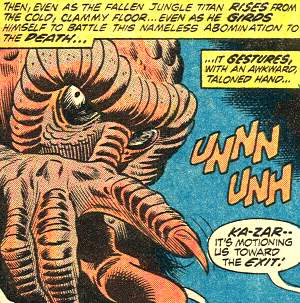 There are plenty of panels in this comic of Man-Thing grunting and growling and otherwise making sub-vocal noises, like above, which, as we Fans o'Manny know, more or less contradicts nearly every other appearance of the character. And, also contradictory is the idea that Man-Thing has it together enough to point other characters toward an exit, which requires more reasoning power than Man-Thing is supposed to have. Also in the story the captions make reference to Man-Thing having a brain, and when Ka-Zar checks an apparently-dead Man-Thing for life, he hears Manny's beating heart. Needless to say, the Manny we know and love has neither of these things. Now, I'm not listing all this to be a jerk (for once). I simply find this comic to be an interesting example of trying to nail down attributes for a brand new character...attributes that may have been altered or discarded over the years since. It still seems a little strange to be reading a story where Man-Thing actually growls and shows more brain-power than normal. Speaking of Man-Thing, he gets a swell cover on this week's new issue of Alter Ego (#81), as well as an article about the character's creation. Apparently a lawsuit was, at least, briefly considered against DC for their Swamp Thing character. I didn't know that. Anyway, the article contains lots of information of interest to the swamp creature enthusiast. Also, having seen the preview copies for next week, Man-Thing puts in an appearance in a Marvel book coming this Wednesday. Which one will it be... which one? (Oh, okay, it's Marvel Zombies 3.) Anyway, that's enough Man-Thing for now...here, have another helping of Zabu: 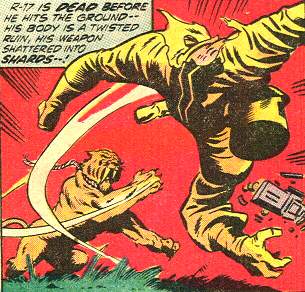 images from Astonishing Tales #13 (Aug. 1972) by Roy Thomas, John Buscema, Rich Buckler, and Dan Adkins
Wednesday, October 01, 2008
"I didn't miss, son!"
And now, the mercy of the Sub-Mariner: 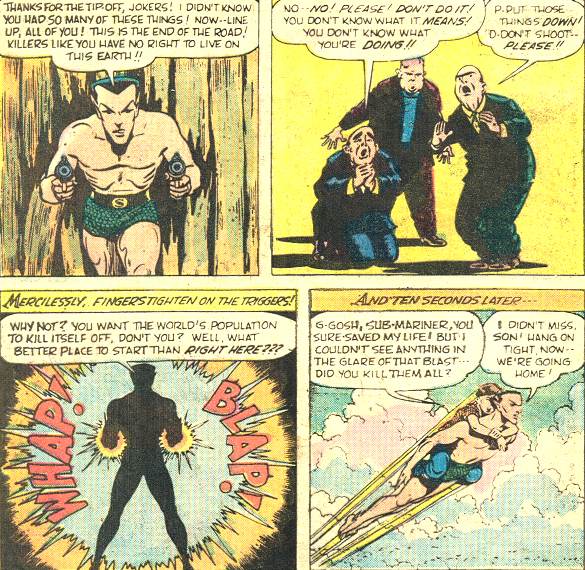
from Sub-Mariner #38 (Feb. 1955) by Bill Everett
- reprinted in Giant-Size Defenders #3 (1975)1. Those are the bad guys' "death ray weapons" that Subby is holding -- hence the "WHAP! BLAP!" sound effects that, you know, all death rays make. 2. I'd give anything for Sub-Mariner to talk like that again. "Thanks for the tip-off, jokers!" C'mon, that's gold.
Tuesday, September 30, 2008
Really, that Ghost Rider appearance was totally out of left field.
So, the other day I was watching an episode of the mid-1990s Fantastic Four cartoon, which adapted the 1982 Terrax/Galactus storyline from FF #s 242 through 244. Here's the cover of the middle installment, just so this post isn't all boring text: 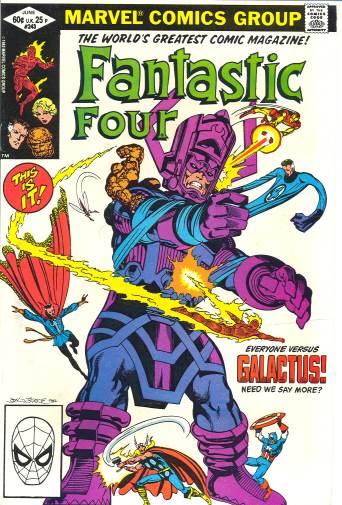 Anyway, the episode takes this three-issue storyline, including the introduction of Frankie Raye and the "she's got powers like the Human Torch" storyline from the previous year's continuity, and manages to squeeze it all into a 20-something minute episode. Most of the storyline's plot points from the original comics make it into the show, with some adjustments here and there. The most noticeable change is that, instead of the guest-starring-superhero free-for-all like you see on that cover up there, the only guy that shows up in the cartoon is Thor. And taking the place of Dr. Strange is Ghost Rider, who in the cartoon puts the mystical showing-Galactus-the-souls-of-his-victims whammy on the big G that Strange did in the comic. Apparently this was Ghost Rider's first appearance in the cartoons, judging by the reaction of the other characters. He just pops up, says "hello," gives Galactus the ol' magical hairy eyeball...er, eyesocket, and takes off, confusing children watching at home everywhere. But the story plays out more or less the same in the cartoon as in the comic...Galactus' reserves are depleted and he's on the verge of dying, Reed Richards decides to save his life, Frankie volunteers to become the new Herald of Galactus and lead him to a new world to consume, and Galactus takes off, vowing to never trouble Earth again and notes that this is the one world where he may have friends. The end. There's another change I should note, concerning Frankie's characterization. In the comic, she had a habit of using excessive force on the bad guys, giving as her reasoning, "well, they're bad guys, right? So what?" When she decides to sacrifice herself to become a Herald, it's pointed out that she'd likely have to lead Galactus to inhabited worlds for him to consume. Her response: "So? A few bug-eyed monsters? What's that compared to my being able to go...out there?" An amoral stance for a superhero-type, to be sure, and it's not surprising that it didn't make it into the cartoon. In its place we get some very broad hinting that Frankie may be, if not outright falling in love with Galactus (a plot development that turns up in later FF issues), at least completely admiringly awestruck by him. Not quite sure why I'm so fascinated by these comic-to-cartoon translations of specific storylines I enjoyed as a younger Mikester. Particularly since the end result, after having watched this episode, is the realization that as profound and significant it all seemed on the printed page, seeing essentially the same story in animated form made it all feel a bit...silly, I guess. Perhaps it's just the nature of the bare-bones condensing of the original tale, or perhaps it's just the recontextualizing of the story from the familiar printed format to an animated one, forcing us to reconsider the storytelling tropes freed of nostalgic memories (see also: the '60s Batman TV show, discussed previously). Or perhaps I'm just overthinking a cartoon whose primary purpose was to sell toys to children. But, honestly, that Terrax/Galactus story from Fantastic Four #s 242 through 244 is really good. And maybe a little silly, but there's nothing wrong with that.
Monday, September 29, 2008
"Oh, man, this guy's going on for a third day about the whole 'death of Jonah Hex' thing? This blog sucks."
Well, yeah, I do have a few more things to say about Hex, but only briefly. Don't panic. I was going to bring up some of Jonah Hex's other time-travel/non-traditional western encounters, specifically in light of his appearance in the recent Justice League animated series, where Hex clearly is aware of the concept of time travel and is able to I.D. the Leaguers as being from the future. Well, you folks beat me to it in yesterday's comments section, with this anonymous commentator whipping out specific cites to Jonah's wandering about the DC Universe. 'Course, he gives out the titles in shortened form, and if you're able to identify them all in row without stumbling, you get a cookie. (NOTE: Get your own cookie, I'm not gonna mail you one.) What's interesting, I think, about the Justice League cartoon appearance is that the idea of Jonah being the Old West character that Weird Sci-Fi/Horror Shit Happens To is apparently been mainstreamed into the character's concept. Even in the current Jonah Hex series, which while generally playing the comic as a straight western, featured supernatural elements in its Halloween issue. I think I remember reading somewhere, too, that one of the proposed concepts for the theoretical film adaptation would have incorporated the Vertigo Comics' horror-themed Hex stories. (I didn't Google that up, so if someone has more recent, reliable, movie information, feel free to drop it in the comments.) So, in short, I like the well-traveled-in-time-and-space Jonah Hex. Here's to more of that sort of thing. An addendum to the fate of Hex's stuffed body following the Secret Origin's tale related yesterday. I was looking at the Wikipedia entry, and it states that the body eventually made it into the hands of Booster Gold, who placed it into his "Planet Krypton" restaurant (and visible in the Kingdom Come collection-only epilogue, if I recall correctly). I'm now going to imagine Booster Gold wrestling Hex's body from the hands of the elderly Tall Bird, because it's both cruel and amusing and I'm a bad person. By the way, this blurb was on the cover of Hex #18, the last issue of that series which I was also discussing yesterday, and while I was all ready to make fun of it: 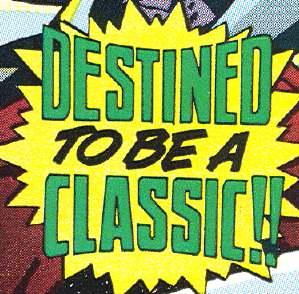 ...I am, after all, still talking about this series, 20+ years after its conclusion. It's a classic to me.
Sunday, September 28, 2008
In which I talk a bit about the ends of various Jonah Hex comics, so consider that a SPOILER warning.
Following up on yesterday's post: Reader Ha-rel asked why ol' Jonah Hex was dead, stuffed and mounted in the first place, and the really short answer, without trying to explain the entire story (as seen in DC Super Special #16, 1978), is that after he was killed in a tavern during a card game, his body was acquired by a traveling circus and put on display. And the last page of that story followed Hex's body from circus to antique shop to warehouse to standing in front of a wild west theme park in the early '70s. And honestly, those last two panels, featuring Stuffed Hex just standing out there in the rain while a kid with toy guns play-shoots at him...that's really one of the saddest, most pathetic scenes in comic book history: 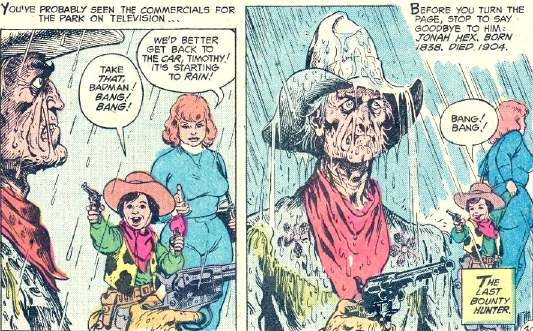 We do get a sequel of sorts in Secret Origins #21 (Dec. '87), which both R.D. and Dwayne -- Dwayne who runs this swell Jonah Hex weblog and I hope doesn't mind me encroaching on his territory a bit, here -- pointed out contains a second case of Hex's dead 'n' stuffed body taking a life. In this case, it's more of a mysterious "who could have pulled the trigger...except the ghost of Jonah Hex, woooOOOOoooo!" thing instead of that dope triggering the guns himself as shown in yesterday's post. In any case, this story, which takes place presumably in the mid/late-'80s, ends with a character promising to retrieve the mounted body so that Jonah's still-living common law wife, Tall Bird (last seen in that DC Super Special) can put it to rest properly. More on that in a moment, but now it's time for some CONTINUITY! In the Secret Origins tale, Tall Bird relates that Jonah once briefly disappeared to another world: 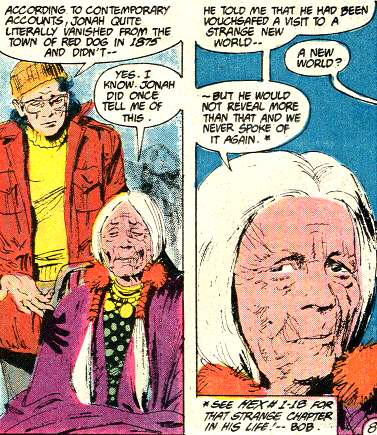 ...which, as that footnote indicates, is a reference to that great series Hex, with Jonah Hex trapped in an apocalyptic future: 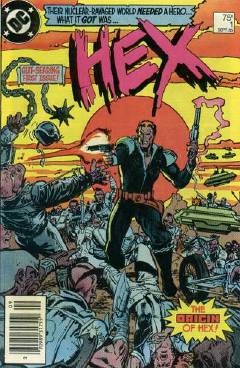 Man oh man, do I love Hex. I've spoken about it before (and funny how there I'm coy about revealing endings, but now I'm all about the Hex spoilers), but one of the things I love most about this series is its last couple of pages in Hex #18 (Feb. 1987). It's the year...oh, I don't know, 2048 or something, and Hex is recovering from injuries and just sorta killing time, toolin' around a warehouse filled with antiques and amusement park materials. And what does he come across but... 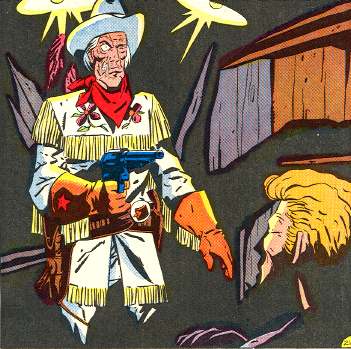
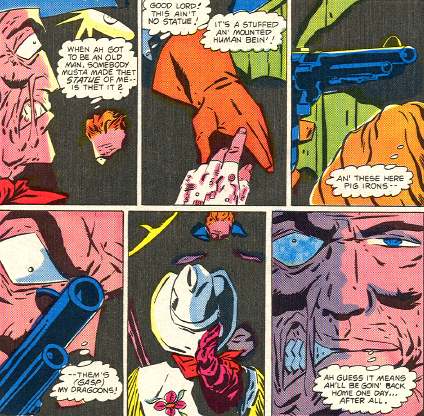 ...and thus, like the Secret Origins comic that follows, establishes that Hex does eventually get back to his rightful time. How he does so is something that's never been revealed, far as I know, and I doubt it'll ever be addressed, unless it turns up as a Booster Gold plot-point or something. And going back to the ending of that Secret Origins story, the happy ending that the story seems to give us, with the impending recovery and return of Hex's body to his wife, is undercut by what we'd read a few months prior in Hex. Tall Bird's intention was to burn the body, apparently, but it obviously doesn't happen if the body is still around for "Road Warrior" Hex to discover in that future warehouse. Don't know if it was stolen, or if Tall Bird simply died of old age before she should have anything done, or what...regardless of the reason, the closure of the story is not quite so closed after all. It's a nice, dark twist, which only has its full impact if you'd been keeping up on your Hex comics, which clearly not many people were since the series was canceled after 18 issues. But really, consider again that the Hex series ends with Jonah Hex face-to-face with his own stuffed and mounted corpse: 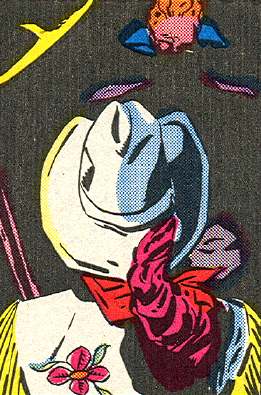 I am both appalled and amused and damn if I don't love this comic. image sources:
Hex #1 (Sept. 1985) - cover art by Mark Texeira & Klaus Janson
Hex #18 (Feb. 1987) by Michael Fleisher, Keith Giffen & Carlos Garzon
Secret Origins #21 (Dec. 1987) by Fleisher & Gray Morrow
DC Special Series #16 (1978) by Fleisher & Russ Heath
| 
















